In June 2022, NTSB completed evaluation of the states’ progress on 10 recommendations from our 2013 report, Reaching Zero: Actions to Eliminate Alcohol-Impaired Driving.
In the 2013 report, we shared that the best hope for meeting the goal of eliminating alcohol-impaired driving is for states and communities to adopt practices proven to work, including:
- Reducing the per se BAC limit,
- Requiring interlocks for all DWI offenders, accompanied by consistent and effective programs to ensure compliance,
- Increasing use of administrative license suspension/revocation laws and providing for use of interlocks in conjunction with license suspensions,
- Providing high visibility enforcement of DWI laws, and
- Continuing efforts to reduce recidivism among DWI repeat offenders.
Although there has been good progress by states in some areas, much more needs to be done to significantly reduce and mitigate crashes related to alcohol-impaired driving.
Below we have listed the safety issue and provided a map depicting progress or lack of progress for each state. An alternate text-based description of the states' progress is also provided. All recommendation statuses are as of June 21, 2022.
For each safety recommendation, green means the state successfully finished implementing the recommendation. Yellow means that efforts are underway that we expect to result in successful implementation. Orange means that so far, the state is failing to implement the safety recommendation.
These plain descriptions align with, but do not replace, the
recommendation definitions provided below the progress maps.
Download the safety recommendation letters referenced in this analysis (PDF format).
ISSUE: BAC Limit of .05
Recommendation H-13-5 - Issued in 2013 to all 50 states, the District of Columbia, and the Commonwealth Puerto Rico:
Establish a per se blood alcohol concentration (BAC) limit of 0.05 or lower for all drivers who are not already required to adhere to lower BAC limits.
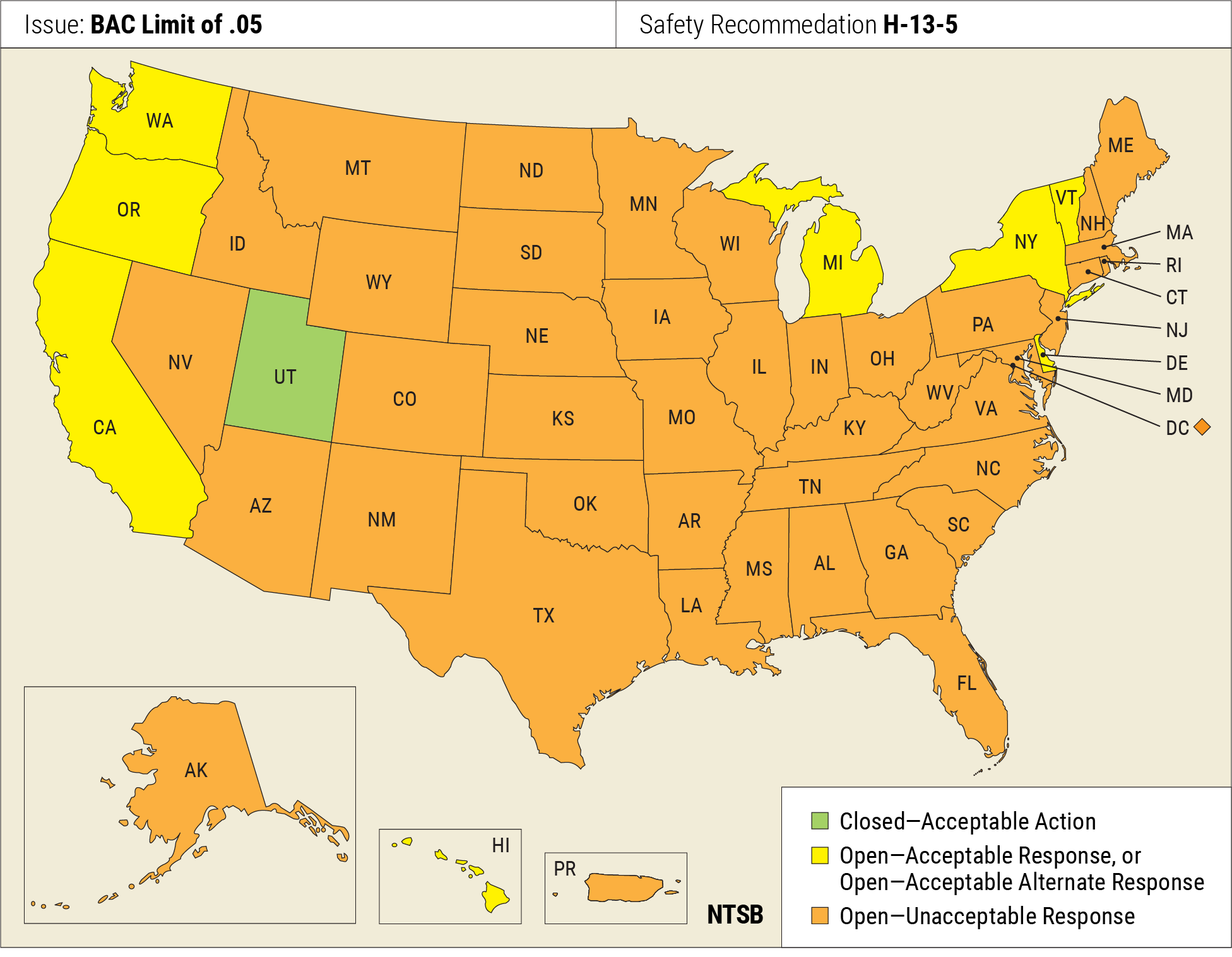
Note: See the full text of the information appearing in this map.
- Only Utah has completed this action.
- 8 states have taken steps to act but have not yet completed the action.
- 43 states have taken no action.
ISSUE: Ignition Interlocks
The NTSB issued one recommendation to the states in 2012, and two in 2013, addressing ignition interlocks:
Recommendation H-12-45 - Issued in 2012 to 33 states, the District of Columbia, and the Commonwealth of Puerto Rico:
Enact laws to require the use of alcohol ignition interlock devices for all individuals convicted of driving while intoxicated (DWI) offenses.
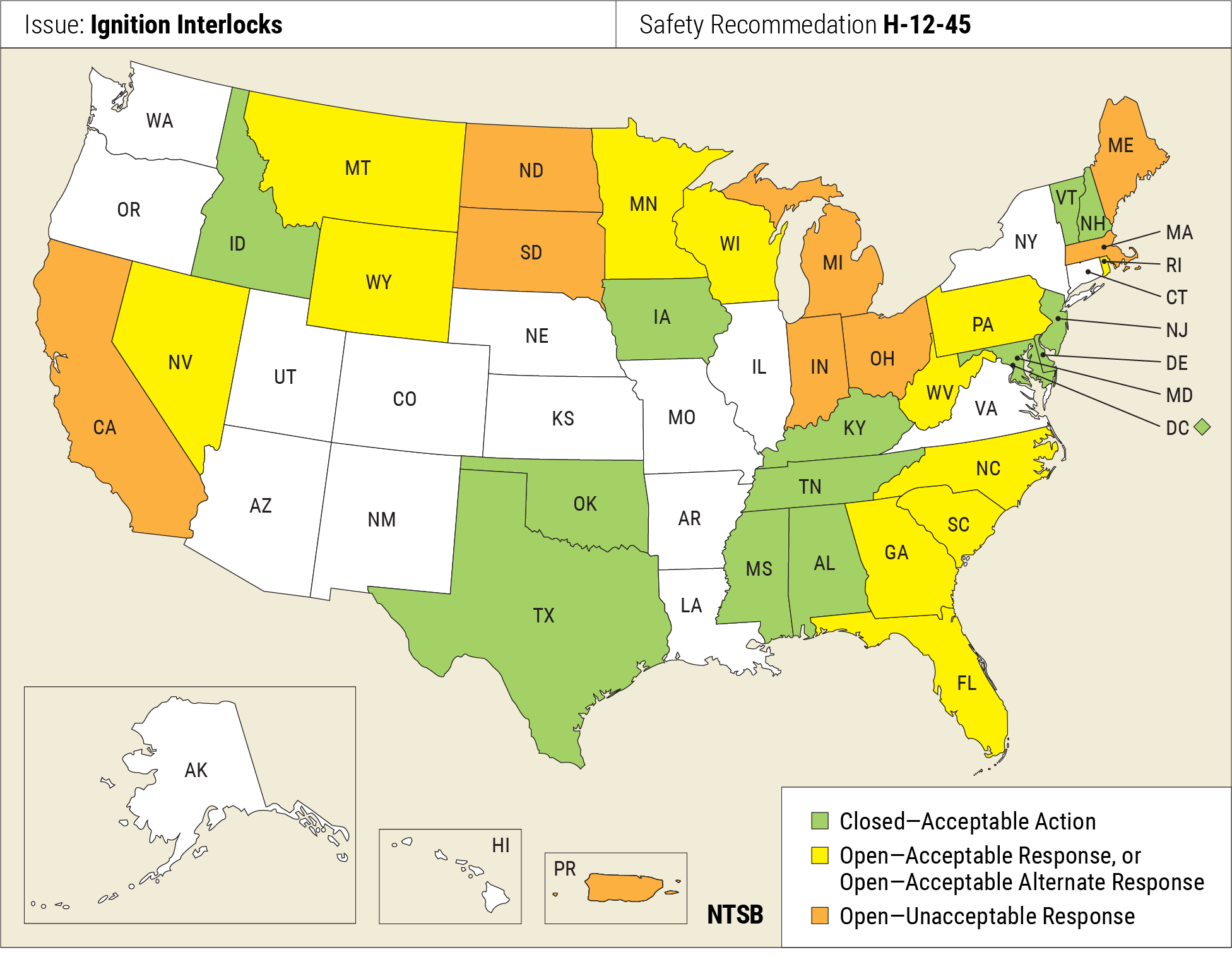
Note: See the
full text of the information appearing in this map.
- 14 states have completed the recommended action.
- 12 states have taken steps to act but have not yet completed the action.
- 9 states have taken no action.
- We did not issue H-12-45 to 17 states because they had addressed the issue before the recommendation was issued.
Note: Tennessee was previously classified Closed—Acceptable Action and this recommendation is not included in their current letter.
Recommendation H-13-9 - Issued in 2013 to the 41 states and the District of Columbia that have administrative license suspension or revocation laws:
Incorporate into your administrative license suspension or revocation laws a requirement that drivers arrested for driving while intoxicated (DWI) use an alcohol ignition interlock on their vehicle for a period of time before obtaining full license reinstatement.
Recommendation H-13-10 - Issued in 2013 to the to the 9 states and the Commonwealth of Puerto Rico that do not have administrative license suspension or revocation laws:
Establish administrative license suspension or revocation laws that require drivers arrested for driving while intoxicated (DWI) to use an alcohol ignition interlock on their vehicle for a period of time before obtaining full license reinstatement.
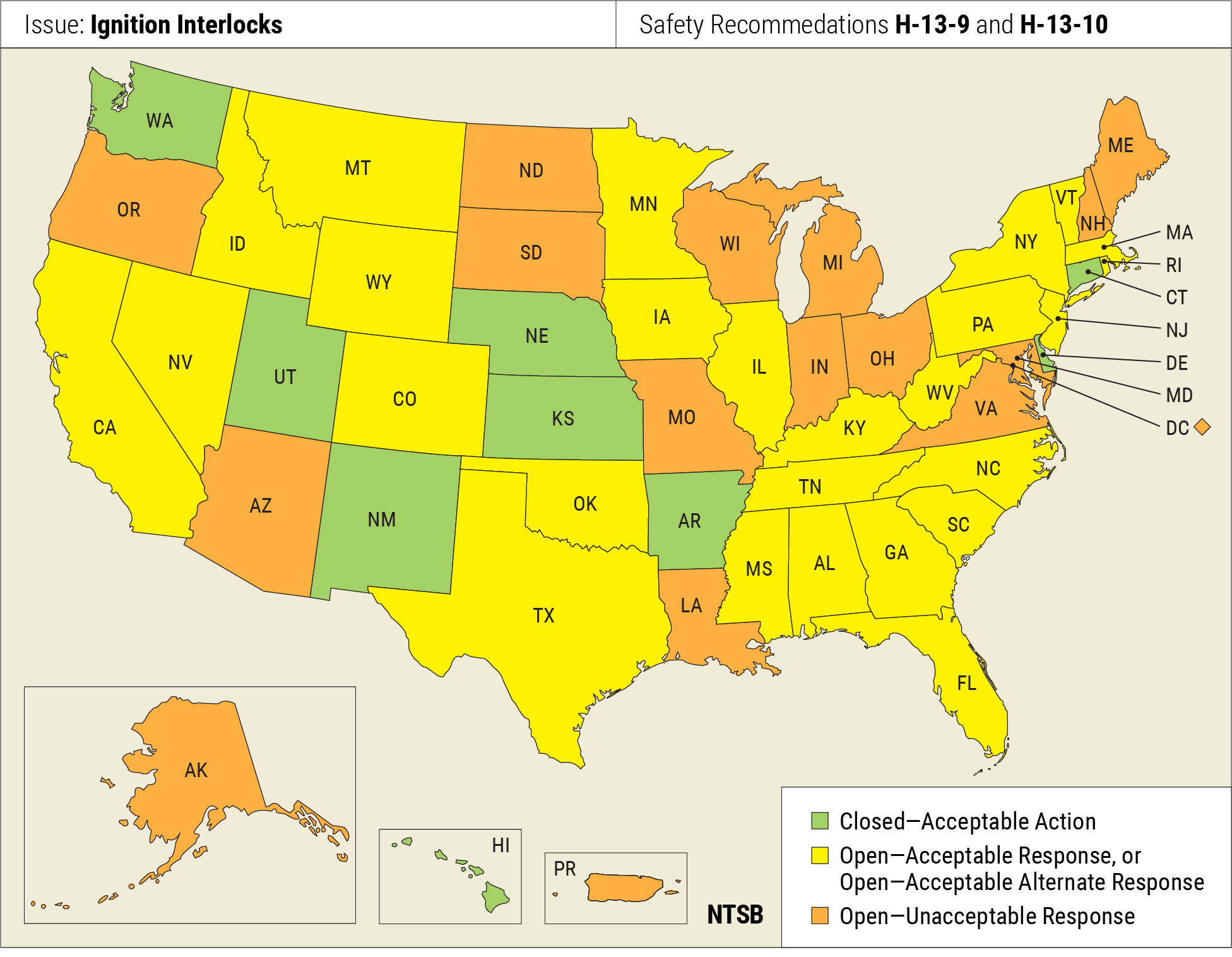
Note: See the
full text of the information appearing in this map.
- 9 states have completed the recommended action.
- 26 states have taken steps to act but have not yet completed the action.
- 17 states have taken no action.
ISSUE: Place of Last Drink
Recommendation H-12-36 - Issued in 2012 to all 50 states, the District of Columbia, and the Commonwealth of Puerto Rico:
Require law enforcement agencies to collect place of last drink (POLD) data as part of any arrest or accident investigation involving an alcohol-impaired driver.
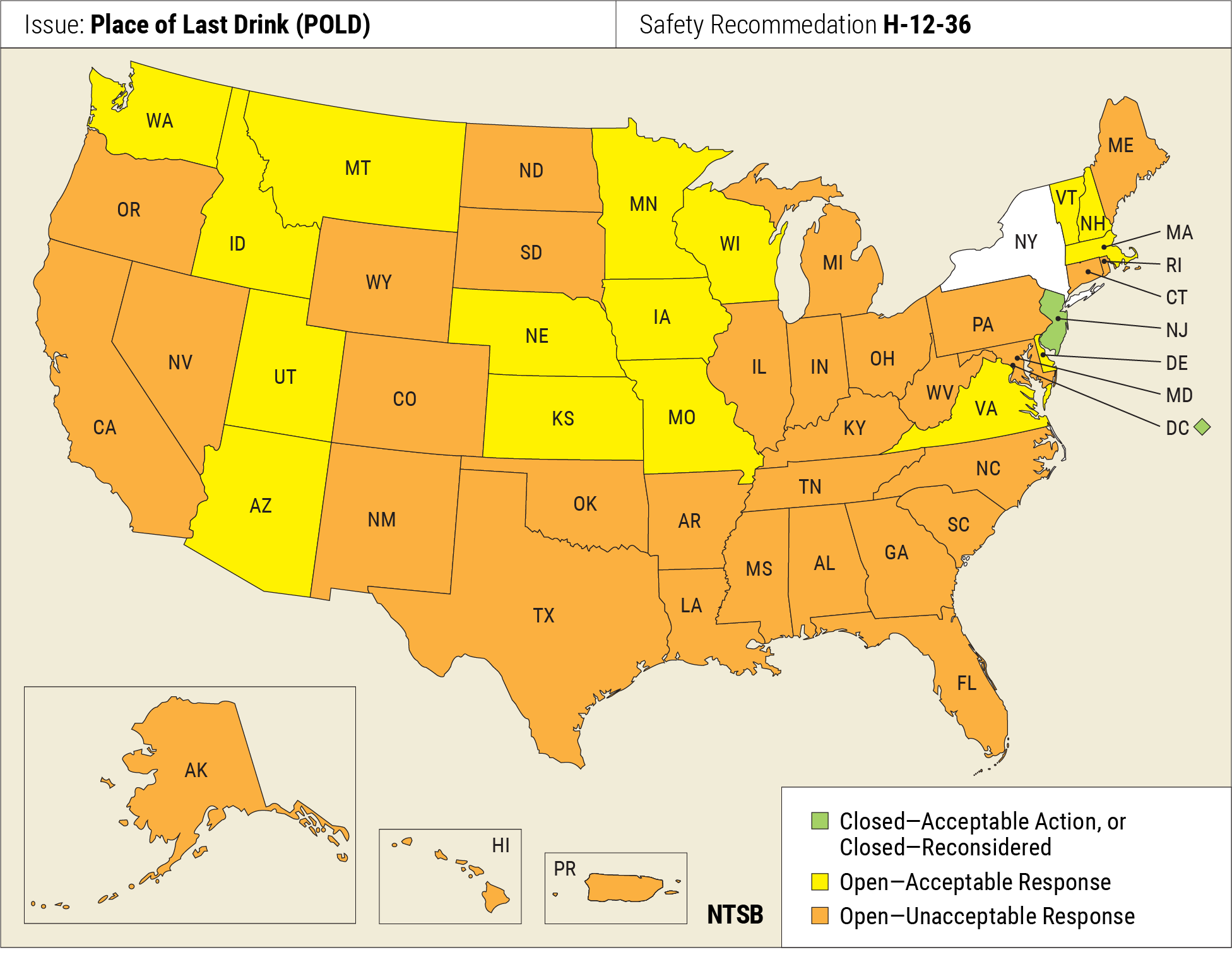
Note: See the
full text of the information appearing in this map.
- 3 states have completed the recommended action.
- 16 states have taken steps to act but have not yet completed the action.
- 33 states have taken no action.
Note: New York was previously classified Closed—Acceptable Action and this recommendation is not included in their current letter.
ISSUE: BAC Testing and Reporting
Recommendation H-12-34 - Issued in 2012 to 45 states, the District of Columbia, and the Commonwealth of Puerto Rico, all of which have low reporting rates for BAC testing:
Increase your collection, documentation, and reporting of blood alcohol concentration (BAC) test results by taking the following actions, as needed, to improve testing and reporting rates: (1) enact legislation, (2) issue regulations, and (3) improve procedures used by law enforcement agencies or testing facilities.
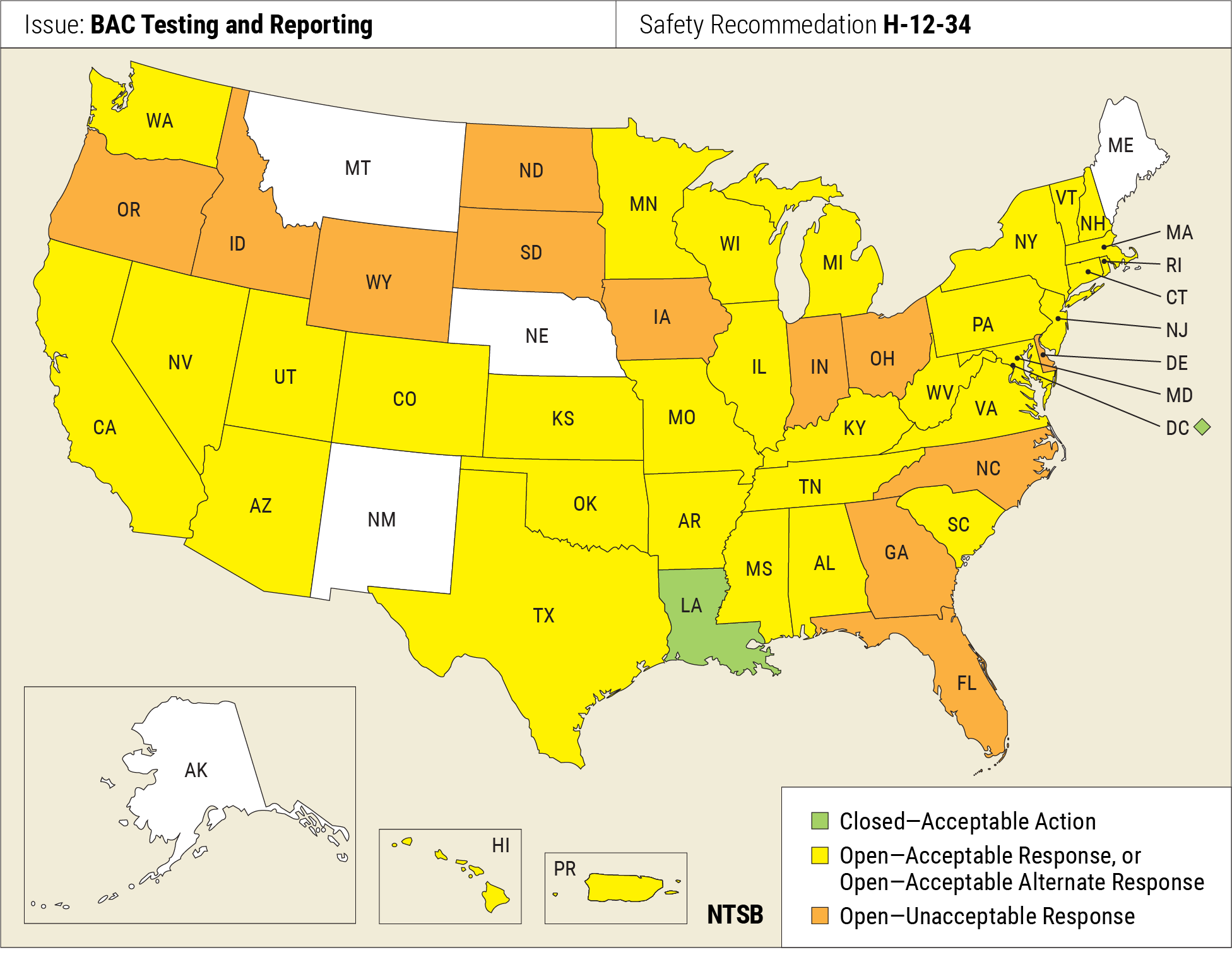
Note: See the
full text of the information appearing in this map.
- 2 states have completed the recommended action.
- 33 states have taken steps to act but have not yet completed the action.
- 12 states have taken no action.
- We did not issue H-12-34 to the 5 states (AK, ME, MT, NE, NM) that had addressed the issue before the recommendation was issued.
Recommendation H-12-35 - Issued in 2012 to 45 states, the District of Columbia, and Puerto Rico, all of which have low reporting rates for BAC testing:
Once the National Highway Traffic Safety Administration has developed the blood alcohol concentration (BAC) testing and reporting guidelines recommended in Safety Recommendation H-12-32, incorporate the guidelines into a statewide action plan to achieve BAC reporting rates of at least 80 percent of fatally injured drivers and at least 60 percent of drivers who survived fatal crashes.
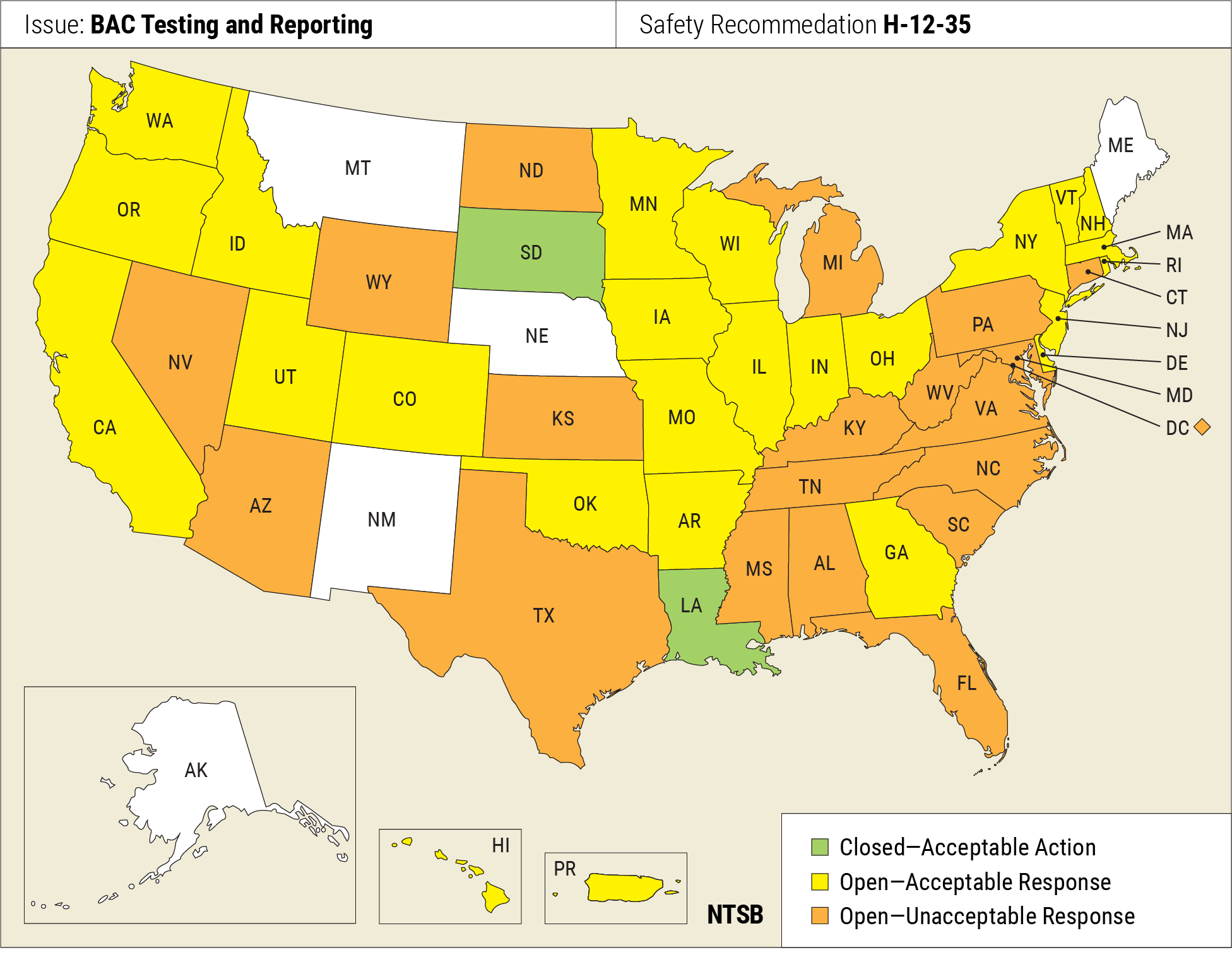
Note: See the
full text of the information appearing in this map.
- 2 states have completed the recommended action.
- 25 states have taken steps to act but have not yet completed the action.
- 20 states have taken no action.
- We did not issue H-12-35 to 5 states (AK, ME, MT, NE, NM) that had addressed the issue before the recommendation was issued.
ISSUE: High Visibility Enforcement
Recommendation H-13-6 - Issued in 2013 to the 50 states, the District of Columbia, and the Commonwealth of Puerto Rico:
Include in your impaired driving prevention plan or highway safety plan provisions for conducting high-visibility enforcement of impaired driving laws using passive alcohol-sensing technology during law enforcement contacts, such as routine traffic stops, saturation patrols, sobriety checkpoints, and accident scene responses.
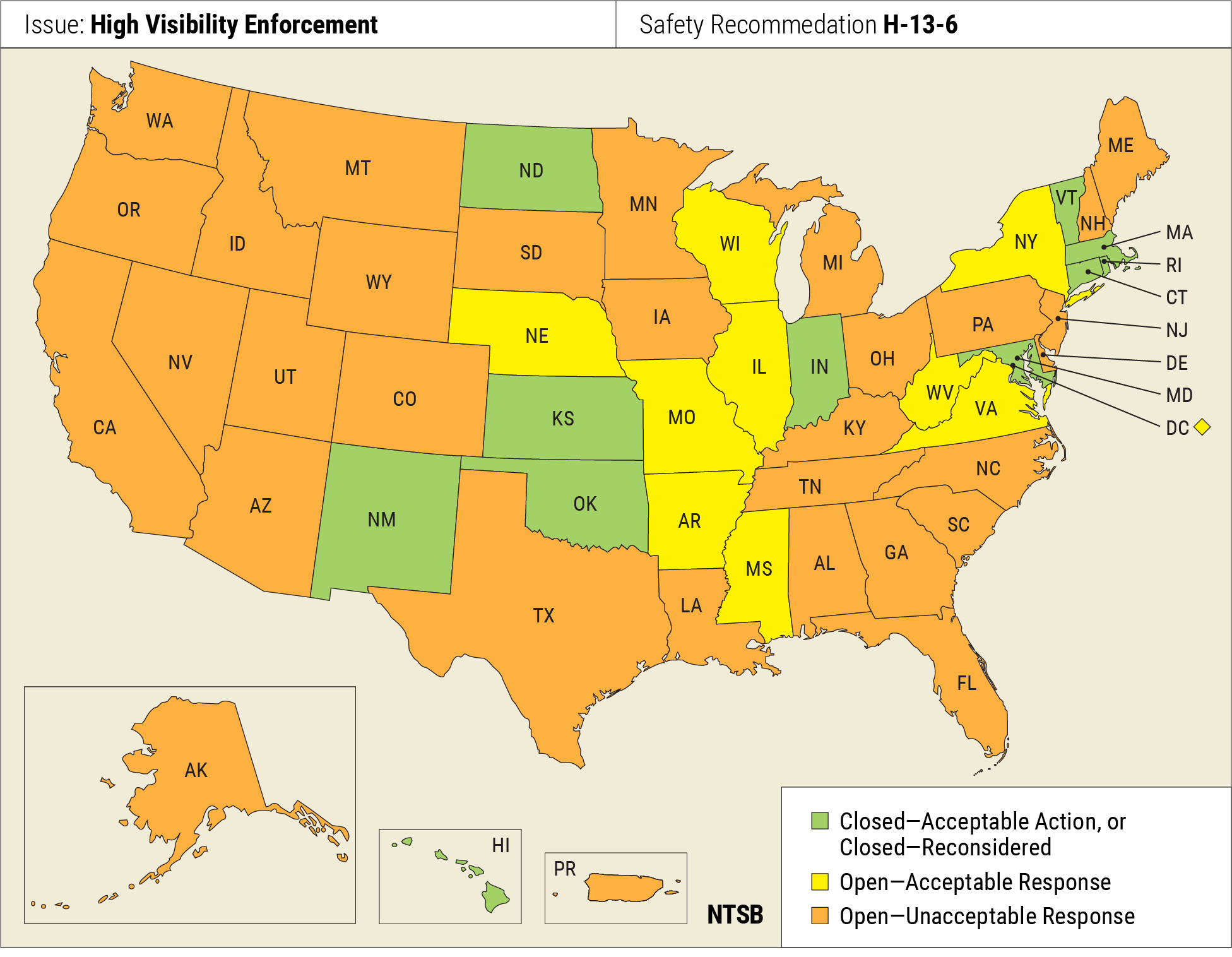
Note: See the
full text of the information appearing in this map.
- 11 states have completed the recommended action.
- 10 states have taken steps to act but have not yet completed the action.
- 31 states have taken no action.
ISSUE: Targeting Repeat Offenders and Reducing DWI Recidivism
Recommendation H-13-7 - Issued in 2013 to the 50 states, the District of Columbia, and the Commonwealth of Puerto Rico:
Include in your impaired driving prevention plan or highway safety plan elements to target repeat offenders and reduce driving while intoxicated (DWI) recidivism; such elements should include measures to improve compliance with alcohol ignition interlock requirements; the plan should also provide a mechanism for regularly assessing the success of these efforts.
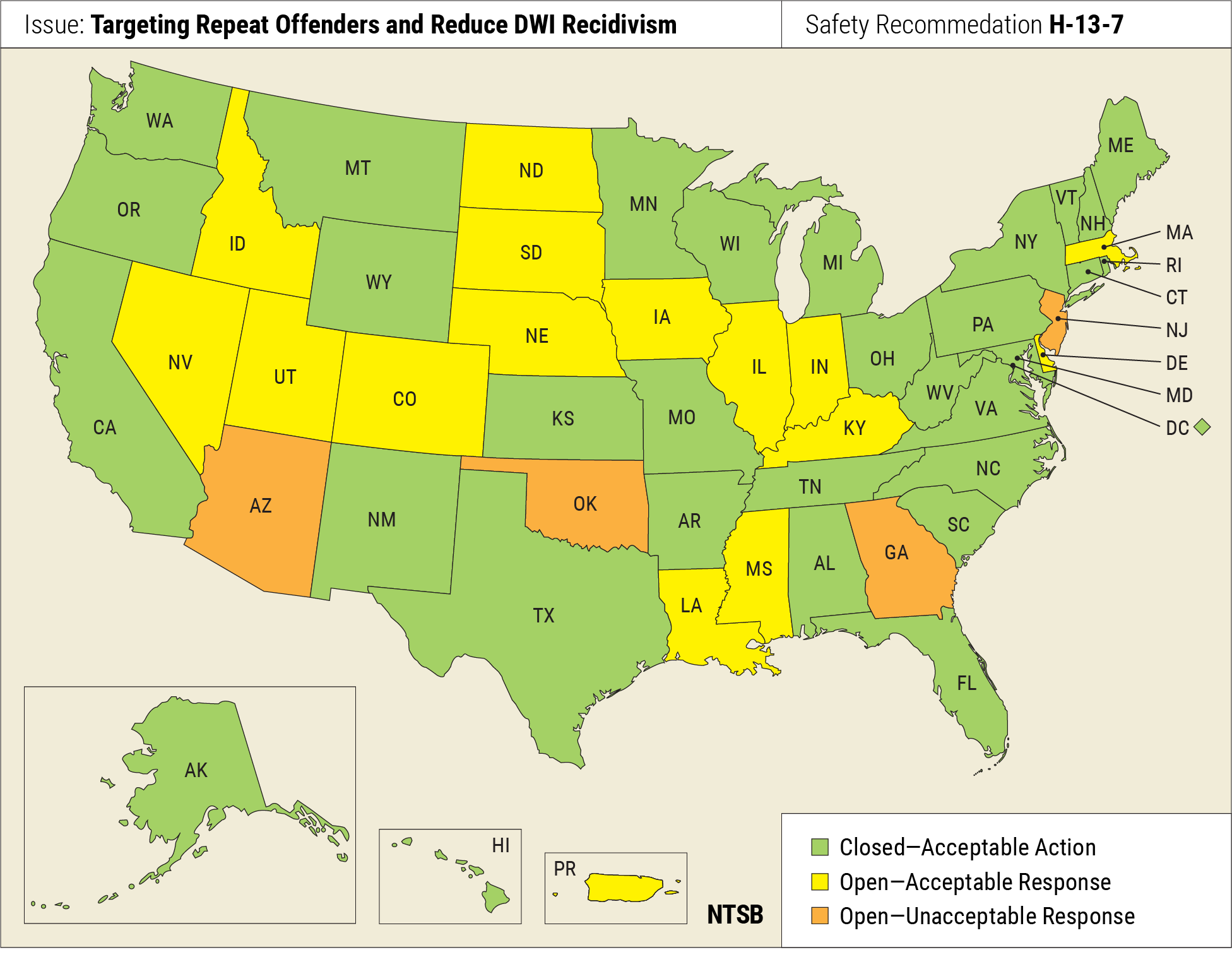
Note: See the
full text of the information appearing in this map.
- 32 states have completed the recommended action.
- 16 states have taken steps to act but have not yet completed the action.
- 4 states have taken no action.
ISSUE: Specific and Measurable Targets for Reducing Impaired Driving Fatalities and Injuries
Recommendation H-13-8 - Issued in 2013 to the 50 states, the District of Columbia, and the Commonwealth of Puerto Rico.
Take the following steps to move toward zero deaths from impaired driving: (1) set specific and measurable targets for reducing impaired driving fatalities and injuries, (2) list these targets in your impaired driving prevention plan or highway safety plan, and (3) provide a mechanism for regularly assessing the success of implemented countermeasures and determining whether the targets have been met.
- Classified Closed—Acceptable Action to all recipients.
Note: North Dakota was previously classified Closed—Acceptable Action and this recommendation is not included in their current letter.
Recommendation Definitions
Closed—Acceptable Action: Recipient response indicates action on the safety recommendation has been completed. The action complies with the safety recommendation.
Open—Acceptable Response: Recipient response indicates a planned action that would comply with the safety recommendation when completed.
Open—Acceptable Alternate Response: Recipient response indicates an alternate plan or implementation program that would satisfy the objective of the safety recommendation when implemented.
Open—Unacceptable Response: Recipient response expresses disagreement with the need outlined in the recommendation or attempts to convince the Board (unsuccessfully) that an alternative course of action is acceptable. The Board believes, however, that there is enough supporting evidence to ask the recipient to reconsider its position. This status can also be used when the Board believes that action is not being taken in a timely manner.
More Information
Most Wanted List - Prevent Alcohol- and Other Drug-Impaired Driving
Media Release -
NTSB Evaluates States’ Progress on Alcohol-Impaired Driving